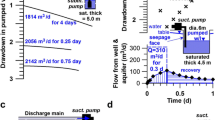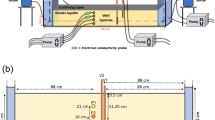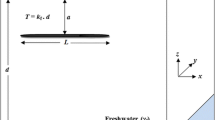Abstract
Water quality tests were performed on two long-screened alluvial aquifer wells (15–30 m of screen) that had been completed in a heterogeneous aquifer that exhibits extreme temporal water quality variability. When stressed, the total dissolved solids (TDS) in one well decreased from 10,600 to 3,500 mg/L and in another well the TDS increased from 136 to 2,255 mg/L. Nested short-screened monitoring wells were constructed in chemically distinct horizons affecting each well. Water level measurements and solute and isotopic samples were obtained from the production wells and the monitoring wells during a water quality test. Results of a time drawdown tests demonstrate transmissivity differences between horizons. Ambient water quality in the production wells and aquifer cross-contamination are controlled by well-bore mixing due to head differences of as little as 0.01 m between chemically distinct horizons which are linked by the production well screen. During non-stress periods, the ambient well-bore chemistry is controlled by the horizon with the greatest hydraulic head, whereas during stressed conditions, horizon transmissivity controls the well-bore chemistry. In one well, aquifer cross-contamination, driven by an ambient head differential of 1.2 m, persisted until about 1,600 well-bore volumes were purged.
Résumé
Des essais sur la qualité de l’eau ont été réalisés sur deux forages crépinés d’un aquifère alluvial (15–30 m de crépines) implantés dans un aquifère hétérogène qui est caractérisé par une variabilité importante de la qualité de l’eau au cours du temps. Lorsque le forage est sollicité par pompage, les solides dissous totaux (TDS) ont des valeurs qui diminuent, de 10,600 à 3,500 mg/L dans un forage, alors que dans l’autre, les TDS augmentent, avec des valeurs passant de 136 à 2,255 mg/L. Un suivi détaillé a été effectué à l’aide d’un dispositif dans des forages crépinés où des horizons chimiques distincts sont présents. Des mesures piézométriques ainsi que des échantillons ont été prélevés pour effectuer des analyses de solutés et des analyses isotopiques au niveau du forage en production et des piézomètres, au cours d’un essai de qualité de l’eau. Les résultats d’essais de restitution au cours du temps indiquent l’existence de différence de transmissivités entre les horizons. La qualité de l’eau dans les forages en production et de l’eau issue de la contamination croisée au sein de l’aquifère sont contrôlées par un mélange d’eau entre les forages due à une différence de charge hydraulique de faible importance (0.01 m) entre les horizons distincts du point de vue chimique mais connectés avec le forage crépiné en production. Lors des périodes de non sollicitation par pompage, la chimie de l’eau du forage est contrôlée par l’horizon possédant le potentiel hydraulique le plus important, alors qu’en conditions de sollicitation par pompage, la transmissivité de l’horizon est responsable de la chimie de l’eau du forage. Dans un forage , la contamination croisée associée à une différence de charge de 1.2 m, persiste jusqu’à ce qu’un volume correspondant à 1,600 fois le volume du forage ait été purgé.
Resumen
Se llevaron a cabo pruebas de calidad de agua en 2 pozos de acuíferos aluviales de filtros largo (15–30 m de filtro) que están completamente ubicados en un acuífero heterogéneo que exhibe una variabilidad temporal extrema en la calidad de agua. Cuando están presionados, el total de sólidos disueltos en un pozo disminuyó desde 10,600 a 3,500 mg/L y en otro pozo se incrementó desde 136 a 2,255 mg/L. Se construyeron pozos de monitoreo de filtros cortos anidados en distintos horizontes químicos que afectaban a cada pozo. Se obtuvieron mediciones de niveles de agua y muestras de soluto e isótopos a partir de los pozos de producción y de los pozos de monitoreo durante una prueba de calidad de agua. Los resultados de un ensayo depresión – tiempo demostraron diferencias en la transmisividad entre los horizontes. La calidad del agua en el ambiente de los pozos de producción y la contaminación cruzada del acuífero son controladas por el mezclado de los pozos debido a diferencias de carga tan pequeñas como 0.01 m entre los distintos horizontes químicos que están vinculados a los filtros de los pozos de producción. Durante periodos de no presión, la química del ambiente del pozo está controlad por el horizonte con mayor carga hidráulica, mientras que en condiciones de presión la transmisividad de los horizontes controlan la química en el pozo. En uno de los pozos con contaminación cruzada de acuífero, forzado por una carga diferencial del ambiente de 1.2 m, persistirá hasta que se purguen el equivalente a alrededor de 1,600 volúmenes del pozo.
摘要
对两口成井于非均质冲积含水层, 且水质随时间变化很大的长滤水管 (滤水管长15-30 m) 井进行了水质检测。抽水时, 一口井的TDS从10600mg/L降到3500mg/L, 而另一口井的TDS则由136mg/L增大到2255mg/L。所以在水化学性质完全不同的含水层层位 (各影响一个井的井水成分) 打了短滤水管巢式监测井。在水质测试期间自生产井和监测井采集了水位、溶质和同位素样品。时间-降深试验的结果表明, 不同层位的导水系数存在差异。抽水井附近水质和含水层的交叉污染由抽水井滤水管连通的水质差别显著的不同含水层间仅0.01m的水头差控制。未抽水时, 井水的水化学由水头最高的含水层决定, 而在抽水时, 则由含水层的导水系数决定。在其中一口井中, 由周围1.2m水头差导致的含水层间交叉污染一直持续到约1600个井孔体积的水被抽出。
Resumo
Foram desenvolvidos testes de qualidade da água em dois furos em aquíferos aluviais com extensões elevadas de tubos-ralo (15–30 m de tubo-ralo) perfurados num aquífero heterogéneo que apresenta uma extrema variabilidade temporal da qualidade da água. Quando sob pressão, devido a exploração, o teor total de sólidos dissolvidos (TSD) de um furo decresceu de 10,600 para 3,500 mg/L, enquanto noutro o TSD aumentou de 136 para 2,255 mg/L. Foi construída uma rede de furos de monitorização com tubos-ralo curtos em camadas quimicamente distintas que afectam cada furo. Foram executadas medições do nível da água e recolhidas amostras de solutos e isótopos dos furos de produção e dos furos de monitorização, durante uma avaliação de qualidade da água. Os resultados dos ensaios de rebaixamento revelam diferenças de transmissividade entre camadas. A qualidade ambiental da água nos furos de produção e a contaminação cruzada de aquíferos são controladas pela mistura nos furos devido a diferenças piezométricas que podem ser tão pequenas como 0.01 m entre camadas quimicamente distintas que estão interconectadas pelos tubos-ralo do furo de produção. Durante períodos em que não há pressão sobre os aquíferos, a qualidade química ambiental dos furos é controlada pela camada com o nível piezométrico mais elevado, enquanto que, durante condições de pressão sobre os aquíferos, a transmissividade das camadas controla a qualidade química dos furos. Num furo, a contaminação cruzada induzida por uma diferença piezométrica ambiental de 1.2 m, durou até se ter extraído um volume equivalente a 1,600 vezes o volume do furo.












Similar content being viewed by others
References
Barber C, Davis GB (1987) Representative sampling of ground water from short screened boreholes. Ground Water 25(5):581–587
Barcelona MJ, Wehrmann HA, Varljen MD (1994) Reproducible well-purging procedures and VOC stabilization criteria for ground water sampling. Ground Water 32(1):12–22
Batu V (1998) Aquifer hydraulics: a comprehensive guide to hydrogeologic data analysis. Wiley, New York, 727 pp
Boylan JA (2004) Chemical artifacts of sampling methods in groundwater. Geol Soc Am Abstr 36(5):242
Britt SL, Tunks J (2003) Thorough mixing of contaminant stringers demonstrated in sand tank ground water model: results support expanded use of no-purge sampling techniques. Proceedings of the NGWA Conference on Remediation: Site Closure and Total Cost of Cleanup, 13–14 November 2003. New Orleans, LA, 14 pp
Capel PD, Kruglov V, Landon MK, Delin GN, Certain HJ (2002) Variations in concentrations of atrazine and nitrate during well purging in relation to field water-quality parameters. Hydrol Sci Technol J 18(1–4):217–230
Church PE, Granato GE (1996) Bias in ground-water data caused by well-bore flow in long-screened wells. Ground Water 34(2):262–273
Clark ID, Fritz P (1997) Environmental isotopes in hydrology. Lewis, Boca Raton, FL, 328 pp
Doelle HW (1969) Bacteria metabolism. Academic, New York
Einarson MD, Cherry JA (2002) A new multilevel ground water monitoring system using multichannel tubing. Ground Water Monit Rem 22(4):52–65
Elci A, Molz FJ, III, Waddrop WR (2001) Implications of observed and simulated ambient flow in monitoring wells. Ground Water 39(6)
Elci A, Flach GP, Molz FJ (2003) Detrimental effects of natural vertical head gradients on chemical and water level measurements in observation wells: identification and control. J Hydrol 28:70–81
Emery PA, Snipes RJ, Dumeyer JM, Klein JM (1973) Water in the San Luis Valley, south central Colorado. Colorado Water Conservation Board Water Resour Circ 18:26
Gibs J, Imbrigiotta TE, Turner K (1990) Bibliography on sampling ground water for organic compounds. US Geol Surv Open-File Rep 90–564
Gibs J, Brown GA, Turner KS, MacLeod CL, Jelinski JC, Koehnlein SA (1993) Effects of small-scale vertical variations in well-screen inflow rates and concentrations of organic compounds on the collection of representative ground-water-quality samples. Ground Water 31(2):201–208
Hanna TM, Harmon EJ (1989) An overview of the historical, stratigraphic, and structural setting of the aquifer systems of the San Luis Valley, Colorado. In: Water in the Valley: a 1989 perspective of water supplies, issues, and solutions in the San Luis Valley. Colorado Groundwater Assoc., Lakewood, CO, pp 1–34
Hardy MA, Leahy PP, Alley WM (1989) Well installation and documentation, and ground-water sampling protocols for the pilot National Water-Quality Assessment Program. US Geol Surv Open-File Rep 89–396
Henrich WJ (1998) Evaluation of a decommissioned water production well as a potential conduit for cross contamination of confined aquifers using heat-pulse flowmeter, temperature and fluid conductivity geophysical logging techniques. Annual Meeting Abstracts, vol 41, Environmental and Engineering Geologists Society, Denver, CO, 96 pp
Hoffmann JP, Phillips JV, Bills DJ, Halford KJ (2006) Geologic, hydrologic, and chemical data from the C aquifer, near Leupp, Arizona. US Geol Surv Sci Invest Rep 2005–5280, 42 pp
Hsieh PA (1996) Deformation-induced changes in hydraulic head during ground-water withdrawal. Ground Water 34(6):1082–1089
Hunt JM (1979) Petroleum geochemistry and geology. Freeman, New York
Huntley D (1976) Groundwater recharge to the aquifers of the northern San Luis Valley, Colorado: a remote sensing investigation, PhD Thesis, Colorado School of Mines, USA, 249 pp
Hutchins SR, Acree SD (2000) Ground water sampling bias observed in shallow, conventional wells. Ground Water Monit Rem 20(1):86–93
Knobel RL (2006) Evaluation of well-purging effects on water-quality results for samples collected from the eastern Snake River Plain Aquifer underlying the Idaho National laboratory, Idaho. US Geol Surv Sci Invest Rep 2006–5234, 52 pp
Lacombe S, Sudicky EA, Frape SK, Unger AJA (1995) Influence of leaky boreholes on cross-formational groundwater flow and contaminant transport. Water Resour Res 31(8):1871–1882
Lohman SW (1972) Ground-water hydraulics. US Geol Surv Prof Pap 708, 70 pp
Martin-Hayden JM (2000a) Sample concentration response to laminar wellbore flow: implications to ground water data variability. Ground Water 38(1):12–19
Martin-Hayden JM (2000b) Controlled laboratory investigations of wellbore concentration response to pumping. Ground Water 38(1):121–128
Martin-Hayden JM, Wolfe N (2000) A novel view of wellbore flow and partial mixing: digital image analysis. Ground Water Monit Rem 20(4):96–103
Mayo AL, Davey A, Christiansen D (2007) Groundwater flow patterns in the San Luis Valley, Colorado, USA revisited: an evaluation of solute and isotopic data. Hydrogeol J 15(2):383–408
Meiri D (1989) A tracer test for detecting cross contamination along a monitoring well column. Ground Water Monit Rev 9(2):78–81
Powell WJ (1958) Ground-water resources of the San Luis Valley, Colorado. US Geol Surv Water Suppl Pap 1379, 284 pp
Reilly TE, LeBlanc DR (1998) Experimental evaluation of factors affecting temporal variability of water samples obtained from long-screened wells. Ground Water 36(4):566–576
Reilly TE, Franke OL, Bennett GD (1989) Bias in groundwater samples caused by wellbore flow. J Hydraul Eng 115(2):270–276
Robbins GA, Metcalf M, Budaj R (2005) Evaluation of purging and sampling bias in conducting remediation compliance monitoring. Geol Soc Am Abstr 31(1):28
Romero J, Fawcett D (1978) Geothermal resources of south central Colorado and their relationship to ground and surface water. State of Colorado, Department Natural Resources, Division Water Resources, Denver, CO, 127 pp
Santi PM, McCray JE, Martens JL (2006) Investigating cross-contaminated aquifers. Hydrogeol J 14(1–2):51–68
Sloto RA (1996) Sampling borehole flow to quantify aquifer cross-contamination by volatile organic compounds. In: Morganwalp DW, Aronson DA (eds) U.S. Geological Survey Toxic Substances Hydrology Program: proceedings of the technical meeting, Colorado Springs, Colorado, 20–24 September 1993. US Geol Surv Water Resour Invest Rep 94–4015, pp 361–368
Sloto RA, Machiaroli P, Towle MT (1992) Identification of a multiaquifer ground-water cross-contamination problem in the Stockton Formation by use of borehole geophysical methods, Hatboro, Pennsylvania. In: SEGEEP Proceedings, 1992, Environmental and Engineering Geophysical Society, Denver, CO, pp 21–35
Varljen ND, Barcelona MJ, Obereiner J, Kaminski D (2006) Numerical simulations to assess the monitoring zone achieved during low-flow purging and sampling. Ground Water Monit Rem 26(1):44–52
Whiticar MJ, Faber E, Schoell M (1986) Biogenic methane formation in marine and freshwater: CO2 reduction vs. acetate fermentation—isotopic evidence. Geochim Cosmochim Acta 50:693–709
Wolff RG (1970) Relationship between horizontal strain near a well and reverse water level fluctuation. Water Resour Res 6(4):1721–1728
Wolin MJ, Miller TL (1987) Bioconversion of organic carbon to CH4 and CO2. Geomicrobiol J 5(3/4):239–259
Acknowledgements
Special thanks to A. Davey of Davis Engineering Services, and R. Curtus and F. Huss of the Rio Grande Water Conservation District for their help and financial assistance. The paper benefited greatly by reviews from G. Weissmann and an anonymous reviewer. I am particularly grateful for the review, comments, and assistance of K. Halford in revising the pump test data analysis.
Author information
Authors and Affiliations
Corresponding author
Rights and permissions
About this article
Cite this article
Mayo, A.L. Ambient well-bore mixing, aquifer cross-contamination, pumping stress, and water quality from long-screened wells: What is sampled and what is not?. Hydrogeol J 18, 823–837 (2010). https://doi.org/10.1007/s10040-009-0568-2
Received:
Accepted:
Published:
Issue Date:
DOI: https://doi.org/10.1007/s10040-009-0568-2




